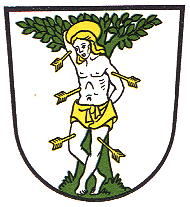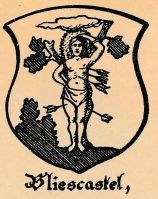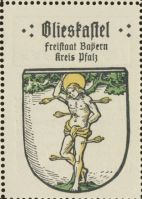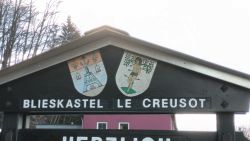Blieskastel: Difference between revisions
Knorrepoes (talk | contribs) m (Text replacement - "{{de}}" to "") |
Knorrepoes (talk | contribs) No edit summary |
||
| Line 1: | Line 1: | ||
'''BLIESKASTEL''' | '''BLIESKASTEL''' | ||
| Line 13: | Line 11: | ||
|- | |- | ||
|'''German''' | |'''German''' | ||
| | | In Silber auf grünem Boden stehend der heilige Sebastian in natürlichen Farben, goldnimbiert, mit goldenem Haar und goldenem Lendentuch, an einen grünen Baum gebunden und mit goldenen Pfeilen durchbohrt. | ||
In Silber auf grünem Boden stehend der heilige Sebastian in natürlichen Farben, goldnimbiert, mit goldenem Haar und goldenem Lendentuch, an einen grünen Baum gebunden und mit goldenen Pfeilen durchbohrt. | |||
|- | |- | ||
|'''English''' | |'''English''' | ||
| Line 25: | Line 22: | ||
The arms were based on an early 18<sup>th</sup> century seal showing St. Sebastian, the patron saint of the main church in the city (which was destroyed in 1928). In 1954 the colours of the city were determined as white and blue. These colours are taken from the arms of the family Von der Leyen (see also [[Simpelveld]]) who had one of their castles in the city. Blieskastel was part of the [[State of Trier]] until 1660 and was ruled by the Von der Leyen family from 1660-1793 as vassals of the bishops of Trier. | The arms were based on an early 18<sup>th</sup> century seal showing St. Sebastian, the patron saint of the main church in the city (which was destroyed in 1928). In 1954 the colours of the city were determined as white and blue. These colours are taken from the arms of the family Von der Leyen (see also [[Simpelveld]]) who had one of their castles in the city. Blieskastel was part of the [[State of Trier]] until 1660 and was ruled by the Von der Leyen family from 1660-1793 as vassals of the bishops of Trier. | ||
<gallery widths=250px heights=200px perrow=0> | |||
| | File:Blieskastel.sc.jpg|alt=Wappen von Blieskastel/Arms (crest) of Blieskastel|The arms in an [[Schuberts Album deutscher Staaten und Städtewappen|album]] from around 1910 | ||
File:blieskastel.hagd.jpg|alt=Wappen von Blieskastel/Arms (crest) of Blieskastel|The arms by [[Otto Hupp|Hupp]] in the [[Kaffee Hag albums]] +/- 1925 | |||
| | File:Blieskastel1.hagd.jpg|alt=Wappen von Blieskastel/Arms (crest) of Blieskastel|The arms by [[Otto Hupp|Hupp]] in the [[Kaffee Hag albums]] +/- 1925 | ||
File:B1lieskastel1.jpg|alt=Wappen von Blieskastel/Arms (crest) of Blieskastel|The arms in the town (with [[Le Creusot]]) | |||
</gallery> | |||
[[Civic Heraldry Literature - Germany|'''Literature''']]: Stadler, 1964-1971, 8 volumes. | [[Civic Heraldry Literature - Germany|'''Literature''']]: Stadler, 1964-1971, 8 volumes. | ||
Revision as of 11:33, 25 March 2023
BLIESKASTEL
State : Saarland
District (Kreis) : Saarpfalz Kreis
Additions : 1974 Altheim, Assweiler, Ballweiler, Bierbach, Biesingen, Blickweiler, Böckweiler, Breitfurt, Brenschelbach, Mimbach, Neualtheim, Niederwürzbach, Webenheim, Wolfersheim
| German | In Silber auf grünem Boden stehend der heilige Sebastian in natürlichen Farben, goldnimbiert, mit goldenem Haar und goldenem Lendentuch, an einen grünen Baum gebunden und mit goldenen Pfeilen durchbohrt. |
| English | No blazon/translation known. Please click here to send your (heraldic !) blazon or translation |
Origin/meaning
The arms were officially granted on June 6, 1983. Although the arms were approved by King Ludwig I of Bayern in 1837, and widely used since, they were not officially granted.
The arms were based on an early 18th century seal showing St. Sebastian, the patron saint of the main church in the city (which was destroyed in 1928). In 1954 the colours of the city were determined as white and blue. These colours are taken from the arms of the family Von der Leyen (see also Simpelveld) who had one of their castles in the city. Blieskastel was part of the State of Trier until 1660 and was ruled by the Von der Leyen family from 1660-1793 as vassals of the bishops of Trier.
The arms in an album from around 1910
The arms by Hupp in the Kaffee Hag albums +/- 1925
The arms by Hupp in the Kaffee Hag albums +/- 1925
The arms in the town (with Le Creusot)
Literature: Stadler, 1964-1971, 8 volumes.




